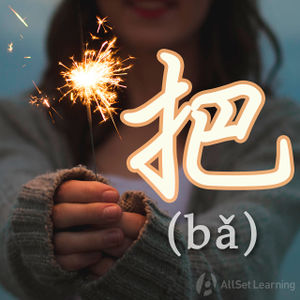Difference between revisions of "Advanced uses of "ba""
| Line 31: | Line 31: | ||
<div class="jiegou"> | <div class="jiegou"> | ||
| − | <strong>把</strong>+ Obj.+ <strong>当作/看作</strong> + something else | + | <strong>把</strong>+ Obj.+ <strong>当作 / 看作</strong> + something else |
</div> | </div> | ||
| Line 37: | Line 37: | ||
<div class="liju"> | <div class="liju"> | ||
| − | * | + | * 我 <em>把</em> 他 <em>当作</em> 我 哥哥。<span class="trans">I see him as my older brother.</span> |
</div> | </div> | ||
Revision as of 05:49, 27 April 2016
| This article is a stub. Editors can help the Chinese Grammar Wiki by expanding it. |
-
Level
-
Similar to
-
Used for
-
Keywords
- Also known as: 把字句 ("bǎ"zìjù), 把 construction, preposition 把, disposal construction and pre-transitive 把.
Once you've gotten the hang of the basic 把 (bǎ) sentence pattern, you can start to use it in some more complex and abstract ways.
Contents
把...给sentence pattern
Used in oral Chinese to add emphasis when dealing with something.
Subject + 把 + Object 给+ Verb Phrase
- 我 把 这 事儿 给 忘 了 。I forgot about this thing.
- 周末 我 把 脏 衣服 给 洗 了 。On weekends, I wash the dirty clothes.
- 你 能 把 这 些 都 给 记住 吗?Will you be able to remember all of this?
To treat as
When you want to say that something is treated as something else, use this pattern.
把+ Obj.+ 当作 / 看作 + something else
- 我 把 他 当作 我 哥哥。I see him as my older brother.
See also
Sources and further reading
Books
- A Practical Chinese Grammar For Foreigners (外国人实用汉语语法) (pp. 461-70) →buy
- Basic Patterns of Chinese Grammar (pp. 53-4) →buy
- Chinese: An Essential Grammar, Second Edition (pp. 159-64) →buy
- Chinese Grammar Without Tears (简明汉语语法学习手册) (pp. 167-81) →buy
- Common Chinese Patterns 330 (汉语常用格式330例) (pp. 3-5) →buy
- Integrated Chinese: Level 1, Part 2 (3rd ed) (pp. 142-4) →buy
- Integrated Chinese: Level 2, Part 2 (pp. 225-7, 321-3) →buy
- Mandarin Chinese: A Functional Reference Grammar (pp. 463-92) →buy
- Modern Mandarin Chinese Grammar: A Practical Guide (pp. 354-5) →buy
- New Practical Chinese Reader 2 (新实用汉语课本2) (pp. 41-2, 88) →buy
- New Practical Chinese Reader 3 (新实用汉语课本3) (pp. 15, 51, 101-2) →buy
- 40 Lessons for Basic Chinese Course (基础汉语40课下册) (pp. 369-70, 384, 398-9)→buy
Websites
- Mandarin Essential Grammar (Yale): 把 Construction
- CTCFL (Oxford): The 把 Construction
- ChinesePod: Qing Wen - The Magic Word 把 (free podcast content)
- ChinesePod: Qing Wen - 把 Humbug (free podcast content)
- FluentU: The Definite Guide to the Chinese Ba Construction
- Mandarin Online: 把字句
- Just Learn Chinese (blog): Lesson 10 How to understand and use Chinese sentence pattern “…把…”?



